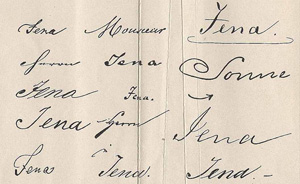
 The basic idea is a rather simple one: by the strokes of his pen, man records significant evidences revealing the secrets of his character and true nature. Thus, reliable anthropological knowledge results less from the written utterances and their propositions – subjects of manifold skills of manipulation – than from the unmistakable traces of man's hand.
The basic idea is a rather simple one: by the strokes of his pen, man records significant evidences revealing the secrets of his character and true nature. Thus, reliable anthropological knowledge results less from the written utterances and their propositions – subjects of manifold skills of manipulation – than from the unmistakable traces of man's hand.
Writing was first designed to be a self-recording system of knowledge about individuality in the context of Johann Caspar Lavater’s sensational Essays on Physiognomy (Physiognomische Fragmente, zur Beförderung der Menschenkenntnis und Menschenliebe, 4 vol., 1775-1778). Its methodical routine as well as its name (i.e. graphology) the evaluation of these traces gets in the second half of 19th century. Despite its partly offensive institutional efforts and its well-timed connections to fin-de-siècle psychology, psychiatry, and criminology, graphology remains a controversial, if not dubious part of anthropology. Even its supporters soon split up into at least two parties disputing the scope of graphological knowledge. ›Minimalists‹ inclined to its limitations on the identification of individuals from the strokes of their pen (e.g. in forensic graphology), while ›maximalists‹ tended to claim a complete interpretation of individual personality, considering the traces of writing as expressions of character.
Nonetheless, or maybe in fact because of this discord, the history of graphological knowledge can be regarded as a model of the genealogy of modern anthropology as well as of for the central role systems and functions of notation play. Oscillating between the concepts of individuality and subjectivity, between the competences of physical/psychological and cultural anthropology, between the effects of the dispositif of literacy and those of corporeality, graphology covers the complete area in which both scientific and cultural knowledge of man has been made in the past three centuries.